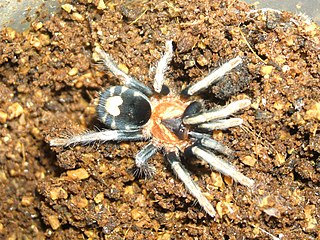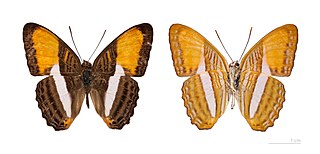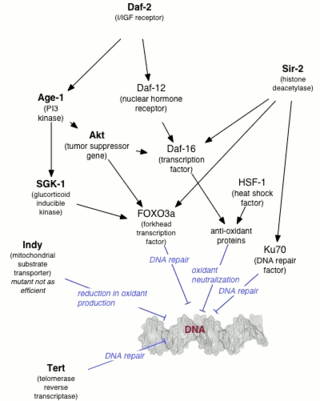
Desperate Remedies is the second novel by Thomas Hardy, albeit the first to be published. It was released anonymously by Tinsley Brothers in 1871.

Joseph Hergesheimer was an American writer of the early 20th century known for his naturalistic novels of decadent life amongst the very wealthy.

Cassieardolla Story, known professionally as Cytherea, is an American pornographic actress and model. She is known for her ability to ejaculate while performing sex acts.

Abracadabrella is a genus of spiders in the family Salticidae whose species appear to mimic flies. The type species for the genus was described by Ludwig Koch (1879) as Marptusa elegans, transferred to Ocrisiona by Eugène Simon (1901) then placed into Abracadabrella by Marek Żabka (1991).

Most animal testing involves invertebrates, especially Drosophila melanogaster, a fruit fly, and Caenorhabditis elegans, a nematode. These animals offer scientists many advantages over vertebrates, including their short life cycle, simple anatomy and the ease with which large numbers of individuals may be studied. Invertebrates are often cost-effective, as thousands of flies or nematodes can be housed in a single room.

Mutinus elegans, commonly known as the elegant stinkhorn, the dog stinkhorn, the headless stinkhorn, or the devil's dipstick, is a species of fungus in the Phallaceae (stinkhorn) family. A saprobic species, it is typically found growing on the ground singly or in small groups on woody debris or leaf litter, during summer and autumn in Japan, Europe, and eastern North America. The fruit body begins its development in an "egg" form, resembling somewhat a puffball partially submerged in the ground. As the fungus matures, a slender orange to pink colored stalk emerges that tapers evenly to a pointed tip. The stalk is covered with a foul-smelling slimy green spore mass on the upper third of its length. Flies and other insects feed upon the slime which contains the spores, assisting in their dispersal. Due to their repellent odor, mature specimens are not generally considered edible, although there are reports of the immature "eggs" being consumed. In the laboratory, Mutinus elegans has been shown to inhibit the growth of several microorganisms that can be pathogenic to humans.

Cytherea is a 1924 American silent romantic drama film directed by George Fitzmaurice and starring Alma Rubens, Lewis Stone, Constance Bennett, and Norman Kerry. Based on the novel Cytherea, Goddess of Love, by Joseph Hergesheimer and was adapted for the screen by Frances Marion. Cytherea features two dream sequences filmed in an early version of the Technicolor color film process. The film is also known as The Forbidden Way.

Cyriocosmus elegans is a spider species in the genus Cyriocosmus and the family Theraphosidae (tarantulas) found in Venezuela, Trinidad and Tobago.
Conioscinella elegans is a species of eye flies in the genus of Conioscinella. It is found in Europe.
TRPN is a member of the transient receptor potential channel family of ion channels, which is a diverse group of proteins thought to be involved in mechanoreception. The TRPN gene was given the name no mechanoreceptor potential C (nompC) when it was first discovered in fruit flies, hence the N in TRPN. Since its discovery in fruit flies, TRPN homologs have been discovered and characterized in worms, frogs, and zebrafish.

Adelpha cytherea, the smooth-banded sister, is a species of butterfly of the family Nymphalidae. It is found in the Central and South America.

Acropora cytherea is a stony coral which forms horizontal table like structures. It occurs in the Indo-Pacific Ocean in areas with little wave action, favouring back reef environments from 3 to 20 m depth.

Genetics of aging is generally concerned with life extension associated with genetic alterations, rather than with accelerated aging diseases leading to reduction in lifespan.
C. elegans most commonly refers to the model round worm Caenorhabditis elegans. It may also refer to any of the species below. They are listed, first in taxonomic order and, second, alphabetically.

Cytherea is a genus of bee flies.
Cerdistus elegans is a species of robber flies in the subfamily Asilinae. It is found in Tunisia.
Drosophila elegans is a flower-feeding species of fruit flies, belonging to the family Drosophilidae. It is found in Taiwan and the Philippines in Asia.
Machimus elegans is a species of fly in the family Asilidae, the robber flies and assassin flies. It is found in the Near East.
Cythereinae is a subfamily of bee flies in the family Bombyliidae. There are about 19 genera and 150 species in Cythereinae.











